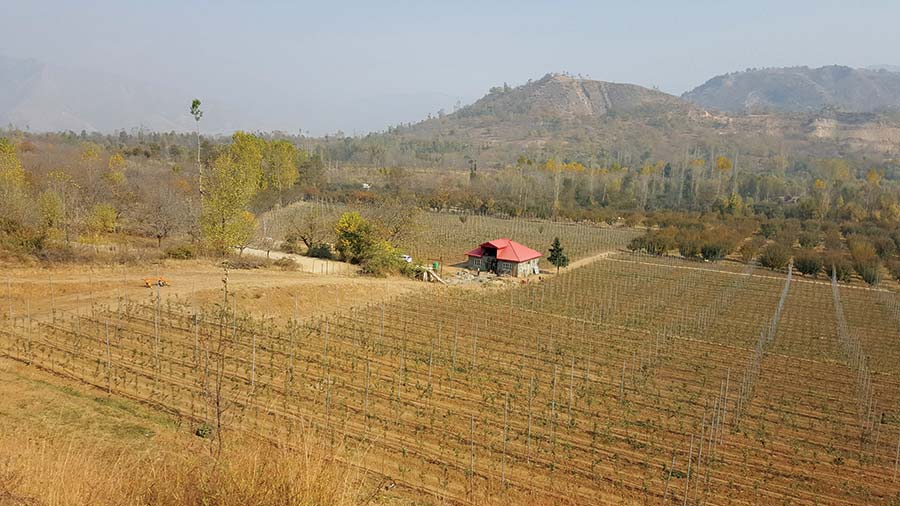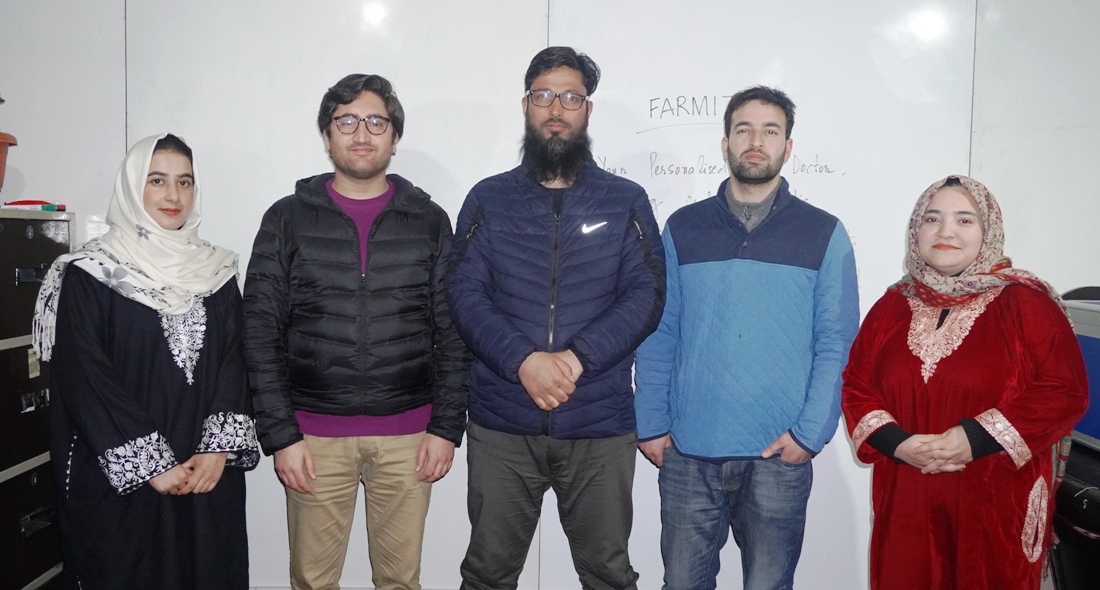With a lot of machines already involved in the apple growing in pre-harvest and post-harvest, it is the turn of taking information technology to the orchard. A group of young men and women have devised a mobile application, though basic but first in Kashmir, that will detect issues in the orchard, the plant and its eco-system to offer solutions using artificial intelligence, machine learning and a lot of pre-stored data on disease, weather and soil, reports Iqra Akhoon
Apple, a key driver in Kashmir’s peripheral economy, has had a rollercoaster ride in the last decade as it moved from traditional management systems, and underwent a series of developments in pre-harvest and post-harvest. It is now time for pushing the sector to embrace information technology (IT). The fruit is about to cross Rs 10,000 crore sale turnover in a few years as the high-density plantations are expected to improve the yield.
A group of five young men and women from diverse fields joined hands and created the first of its kind application that will guide the apple growers to manage their orchards better. The app will converge diverse services to help the grower have precise information about weather, the nutrient requirement of his orchards, soil management, manure use and the use of chemicals. The application, available on Google play store, was launched by start-up FarmIT last week.
Having a massive cell phone penetration, Kashmir’s apple belts would get all the basic information’s about the upkeep of the orchard, free in their mobile sets. They also will have access to talk to experts if they require and avail various testing facilities if they choose so.
Profiling The Orchard
The 8.1mb app will start working from the orchard itself by creating the profile of the plantation post-registration. “The first thing, it will do after the download is that it will track the orchard on the Google maps and give a permanent identity by listing the Google coordinates,” Mursaleen, an engineer, who is part of the star-up said. “These coordinates later help to locate the precise weather conditions in the area and offer a very correct climatic situation to the grower.” A grower can have multiple orchards attached to a single account.

Unlike human beings, Mohammad Ashraf, another techie in the group, believes helping plants is challenging. “It is the interplay of three things,” Ashraf, who has been working to develop tech tools for the farm sector for the last one decade before being part of the start-up, said. “One is the plant, another is the soil in which it grows and third is the climatic conditions. So helping a farmer offer a solution to any problem cannot be done by assessing only one player.”
Once the basic profile of the orchard is recorded, the app will get into the area and seek information about the age and number of the plants. For a ready reference, it will even seek the details of the yield so that it makes a comparison in future. It will also seek information about whether the orchard is high density or low density. Maybe it would seek details about the varieties of the plants for a much better understanding of the orchard.

“This is important because an orchard has multiple varieties and our logs are capable enough to make a distinction and at times the prescriptions to a particular situation can change from one variety of trees to another,” Ruqaya, who is the group’s key pathologist, said. “This is the beauty of machine learning and artificial intelligence.”
Mursaleen said the application is an aggregation of a variety of services from weather to disease. “If a grower notices that the leaves of his plant are changing the colour, he can simply upload a couple of photographs on the application, the machine will get into work,” he said. “There are thousands of similar photographs preloaded on the system and once it matches a particular disease, it will quickly respond by identifying the problem.”
In the second stage, the machine will hunt for the prescription to the particular problem. Subsequently, the user will get step by step guide about how to manage the problem. “We will even send a video about how this problem can be managed,” Mursleen said. “We will prescribe a chemical but we will never guide him to a particular company because he should have the right to make his own choices.”
The app has a directory of all the know diseases that fruit, leaves, plants itself or the soil could be suffering from.
Digital Divide
The five-member group behind the initiative said they have been working for two years to get this basic service to the Kashmir orchards. They are three techies – Mursaleen, Ashraf and Adnan; Ruqaiya, a plant pathologist, and Iqra, an orchard manager with some experience in managing orchard clusters. They obviously have had their struggle to locate people who trusted them and were willing to fund their intervention.
“I have been abroad twice, both times related to horticulture,” Mursleen said, “What I found was that the IT-enabled services have changed the systems in most of the apple-producing countries but back home, we were yet to make a start.” He said the application they have developed is just the beginning and quite basic in nature. “Its success will indicate the quantum of space that the apple economy will give to the IT in near future.”
If the Kashmir apple growers somehow accept the use of IT in the pre-harvest, it eventually is expected to get into the post-harvest as well. In fact, its use in the post-harvest will be immense. In a market, far away, one can actually locate the space of the orchard that produced a particular box of apple the user wishes to buy. It has the potential of creating a new era of relationship between the growers and the consumer, albeit at a small scale. In the next stage, the app will be offering details of the prices from all the mundis within and outside Kashmir so that the grower makes his own choices about what he sells and where.

Vagaries of Weather
The major crisis that the apple growers are facing is the weather. Normally the public broadcasters – the All India Radio and the Doordarshan – and the media, off late, have been offering general information about the weather forecasting for the next 24 hours. But that is too broad to help. It normally is like this – “the weatherman has predicted the possibility of mild rains in upper reaches and cloudy skies in the plains.” It offers no idea to a grower what it means because most of the apple growers believe they are part of the valley plains while the weather stations do not think so because they map the altitudes. In fact, Jammu and Kashmir’s balaie alaqay (upper areas) are so diverse and so over-stretched between Pir Panchal and Harmukh that it is absolutely impossible to make a smart guess. IN Kashmir, where the Western Disturbances are the main weather changer, certain pockets remain least impacted!
A spray is not so easy. It costs. Normally, there should not be any kind of rain in the next 24 hours after the spray is made. If the grower gets this much precise information, even if it is valid for 12 hours, it will make a huge difference. On average, apple growers have almost a dozen sprays till the harvest starts. These sprays take care of various threats including pests, diseases and certain issues dictated by the weather conditions.
Iqra, who has been overseeing a cluster of orchards, said she is aware of the pain that the growers have in deciding whether or not to go for a spray in a sunny day. “I know how the people work in their orchards and lacking certain basic inputs impacts their yield and shatters their expectations,” she said. “Certain weather conditions are linked to the onset of the scab and helping growers locate those days and offering them a solution will alter the yields.”
“Our app is basically an artificial intelligence-based machine. It connects with various weather forecasting systems to offer an idea, which to a huge degree is correct as we saw in the trial runs in the last few months,” one of the developers said. “We do believe that this app will hugely help the grower to get exact information.”
Expert on Call
The application, Ruqaiya said, can guide the grower to seek help in case he is not able to make a decision in case of a particular disease. “We have experts on call and we can depute them to the orchard to make a better analysis of the situation and offer the solution,” Ruqaya said. “We already are linked to the super speciality in the plant management and pathology campuses.”
Mursleen said though the machine will automatically generate a solution based on algorithms and a lot of pre-stored data but the prescription will go to the farmer only after it is physically verified by the pathologists and experts for a cross-check. “It is not important because it is the first time the app will be offered on a mass scale,” Mursleen said. “It is important because we must be sure at our end that what is being suggested is correct. Orchard is just not commerce, it is an emotional issue. Go and talk to growers, they will say their orchards are like their sons.” He insists that the sector is sensitive, and lacks space for any mistake.
The same is the case in soil testing. In case the grower decides that a better understanding of the orchard is required, a simple solid test can detect the issues with the landmass. “Within half an hour, it will help understand the net deficiency in the soil, which can be managed by use of diverse chemical or the manure.”
While techies have developed the app, most of its science has come from academia. “We are always in touch with the serving and the retired faculty because they are the sole experts,” Ashraf said. “We are only helping the science to get disseminated at a mass scale.”
The Next Stage
The startup says that they chose apple because it is the prime mover of the economy. Once it is standardized, they said the same application will take care of other fruits like pear, cherry and other fruits.
“The model remains the same, we only will have to add to the list and have enough of data at the backend,” Iqra said. “The app has already undergone a series of tests. We already had two rounds of testing involving a number of growers and it detected things that were settled.” The group has been working for around two years but the last eight months have been very intense.
Financial Model
Right now, the team said they are just in the process of enabling growers to use so that they can make a difference at their own level. Once that situation is adequately addressed, Mursleen said, the group will devise ways and means to monetise. “We have not thought about it because tensions of returns sometimes kill the initiative,” he said.
They have developed the app in android in the first go and in the second stage; they will get into the IoS because a sizable chunk of apple growers are Apple users.
Developers said that it is also very important to understand that the app is not targeted at the entire mass base of the growers, which could be upward of half a million at least. “They are so experienced that they know what the disease is, how to manage it, maybe precise weather alerts may attract them,” one of them said. “This is more targeted towards a new generation that wants to do things in the orchard but lack the precise information about what to do and how”. For new-age growers, it will be the one app solution.















